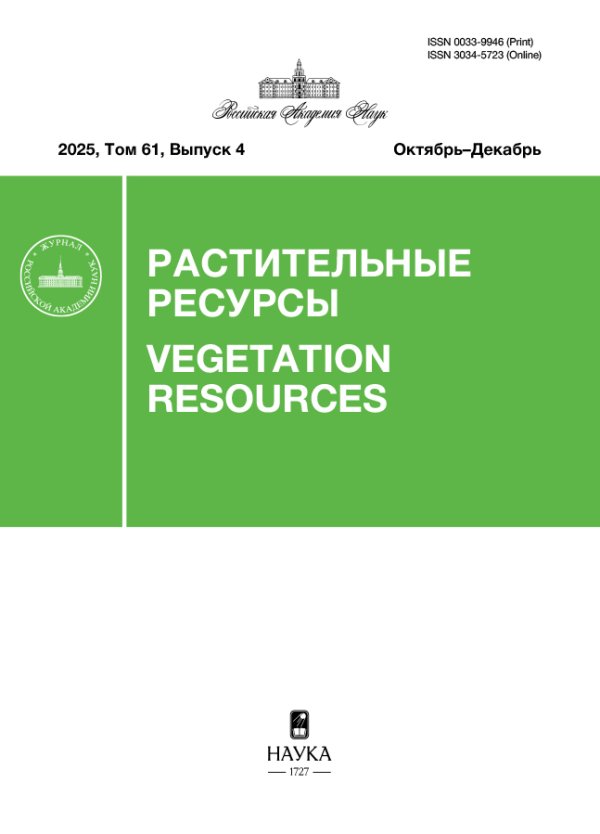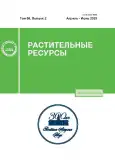Structure of the Ground Vegetation and Natural Regeneration of Tree Species in a 12–15-Year-Old Bilberry Pine Forest–Clear-Cut Ecotone Complex in the Middle Taiga Subzone
- Authors: Genikova N.V.1, Moshnikov S.A.1, Teslya D.V.1
-
Affiliations:
- Forest Research Institute of the Karelian Research Centre of the Russian Academy of Sciences
- Issue: Vol 59, No 2 (2023)
- Pages: 198-214
- Section: АНТРОПОГЕННОЕ ВОЗДЕЙСТВИЕ НА РАСТИТЕЛЬНЫЕ РЕСУРСЫ
- URL: https://journals.rcsi.science/0033-9946/article/view/138788
- DOI: https://doi.org/10.31857/S003399462302005X
- EDN: https://elibrary.ru/ZMRHCR
- ID: 138788
Cite item
Full Text
Abstract
Abstract
—Logging in mature stands, where part of the forest is harvested in one or several cuts and part is retained (clear-cutting and alternate strip cutting) results in the formation of an ecotone complex: forest (F), transition from forest to clear-cut under the canopy (forest edge – FE), transition from forest to clear-cut outside of the canopy (clear-cut edge – CE), and the clear-cut itself (C). Strips 8 m wide on each side of the mature forest/clear-cut site border form the transitional zone. We studied the ground vegetation composition and structure, and the natural regeneration of woody species (Pinus sylvestris L., Picea abies (L.) H. Karst., Betula sp., Populus tremula L., Sorbus aucuparia L., Juniperus communis L.) in the bilberry pine forest – clear-cut ecotone complex 12–15 years after the stand removal. The studies demonstrate that each of the four zones of the ecotone complex formed after logging of the mature forest has its own structural features of ground vegetation and undergrowth (including tree regeneration). The typical forest (F) habitat is characterized by the minimum number of young regeneration of Pinus sylvestris, Picea abies, Betula sp., Populus tremula, and Sorbus aucuparia and, on the contrary, by the highest abundance of lingonberry V. vitis-idaea L. and bilberry Vaccinium myrtillus L., and the maximum height of bilberry plants and their yield. The amount of tree regeneration in the FE is almost the same as in the F zone. The projective cover, maximum shoot height and yield of bilberry, and maximum shoot height of lingonberry in the FE zone are reliably lower than in the F zone. The transitional zone on the clear-cut side (CE) and the clear-cut itself (C) are distinguished from the forest sections of the ecotone complex (F and FE zones) by a greater number of deciduous and pine regeneration and the low abundance of dwarf shrubs. The clear-cut itself (C) differs from the CE by the higher abundance of grasses and forbs and an established tree regeneration layer composed of pine, birch, and aspen.
About the authors
N. V. Genikova
Forest Research Institute of the Karelian Research Centre of the Russian Academy of Sciences
Author for correspondence.
Email: genikova@krc.karelia.ru
Russia, Petrozavodsk
S. A. Moshnikov
Forest Research Institute of the Karelian Research Centre of the Russian Academy of Sciences
Email: genikova@krc.karelia.ru
Russia, Petrozavodsk
D. V. Teslya
Forest Research Institute of the Karelian Research Centre of the Russian Academy of Sciences
Email: genikova@krc.karelia.ru
Russia, Petrozavodsk
References
- [Regulations for wood harvesting and details of wood harvesting at wood farms, as stated in the Article 23 of the Forest Code of the Russian Federation]. 2020. № 993. P. 53. http://publication.pravo.gov.ru/Document/View/0001202012180025 (In Russian)
- Kuuluvainen T., Lindberg H., Vanha-Majamaa I., Keto-Tokoi P., Punttila P. 2019. Low-level retention forestry, certification, and biodiversity: case Finland. – Ecol. Process. 8: 47. https://doi.org/10.1186/s13717-019-0198-0
- Martínez Pastur G.J., Vanha-Majamaa I., Franklin J.F. 2020. Ecological perspectives on variable retention forestry. – Ecol. Process. 9: 12. https://doi.org/10.1186/s13717-020-0215-3
- Genikova N.V., Kharitonov V.A., Pekkoev A.N., Karpechko A.Yu., Kikeeva A.V., Kryshen A.M., Obabko R.P. 2020. Structure of bilberry spruce–grass-forbs aspen forest ecotone communities in the Republic of Karelia. – Rastitelnye resursy. 56(2): 151–164. https://doi.org/10.31857/S0033994620020053 (In Russian)
- Genikova N.V., Mamontov V.N., Kryshen A.M., Kharitonov V.A., Moshnikov S.A., Toropova E.V. 2021. Natural regeneration of the tree stand in the bilberry spruce forest–clear-cutting ecotone complex in the first post-logging decade. – Forests. 12(11): 1542. https://doi.org/10.3390/f12111542
- Genikova N.V., Mamontov V.N., Kryshen A.M. 2021. Abundance of forest dwarf shrubs and microclimatic conditions in the bilberry spruce forest–clear-cut ecotone. – Rastitelnye resursy. 57(2): 99–114. https://doi.org/10.31857/S0033994621020059 (In Russian)
- [Geobotanical zoning of the Non-Chernozem region of the European part of the Russian Soviet Federative Socialist Republic]. 1989. Leningrad. 64 p. (In Russian)
- Weather archive. https://rp5.ru. (Accessed: 22.09.2022)
- Tonteri T. 1994. Species richness of boreal understorey forest vegetation in relation to site type and successional factors. – Ann. Zoo. Fennici. 31(1): 53–60. http://www.sekj.org/PDF/anzf31/anz31-053-060.pdf
- Widenfalk O., Weslien J. 2009. Plant species richness in managed boreal forests – Effects of stand succession and thinning. – For. Ecol. Manag. 257(5): 1386–1394. https://doi.org/10.1016/j.foreco.2008.12.010
- Marozas V., Grigaitis V., Brazaitis G. 2005. Edge effect on ground vegetation in clear-cut edges of pine-dominanted forests. – Scand. J. For. Res. 20(6): 43–48. https://doi.org/10.1080/14004080510040986
- Kryshen A.M., Genikova N.V., Presnukhin Yu.V. 2021. Reforestation series of bilberry spruce forests in Eastern Fennoscandia. – Botanicheskii zhurnal. 106(2): 107–125. https://doi.org/10.31857/S0006813621020071 (In Russian)
- Ulanova N.G. 2004. Comparative analysis of vegetation dynamics in uneven-aged spruce oxalis-type forest, catastrophic windthrow and clear-cutting areas in the same forest type. – Bulletin of Moscow Society of Naturalists. Biological series. 109(6): 64–72. http://herba.msu.ru/russian/journals/bmsn/archive/moip_2004_109_6.djvu (In Russian)
- Fenton N.J., Frego K.A., Sims M.R. 2003. Changes in forest floor bryophyte (moss and liverwort) communities 4 years after forest harvest. – Canad. J. Bot. 81(7): 714–731. https://doi.org/10.1139/b03-063
- Berstedt J., Milberg P. 2001. The impact of logging intensity on field-layer vegetation in Swedish boreal forests. – For. Ecol. Manag. 154(1–2): 105–115. https://doi.org/10.1016/S0378-1127(00)00642-3
- Altegrim O., Sjöberg K. 1996. Response of bilberry (Vaccinium myrtillus) to clear-cutting and single-tree selection harvests in uneven-aged boreal Picea abies forests. – For. Ecol. Manag. 86(1–3): 39–50. https://doi.org/10.1016/S0378-1127(96)03794-2
- Stalskaya P.V. 1959. [On the interaction of Avenella flexuosa with its satellites in the wavy hair-grass clear-cutts of different age]. – In: [Principles of clear-cuts typology and its importance for the forest management]. Arkhangelsk. P. 110–115. (In Russian)
- Kryshen A.M., Genikova N.V., Gnatiuk E.P., Presnukhin Yu.V., Tkachenko Yu.N. 2018. Reforestation series of pine forest communities in Eastern Fennoscandia on sandy automorphic soils. – Botanicheskii zhurnal. 103(1): 5–35. https://doi.org/10.1134/S0006813618010015 (In Russian)
- Sokolov A.I. 2006. [Reforestation on the clear-cutts of the North-West of Russia]. Petrozavodsk. 215 p.
- Beliaeva N.V., Gryazkin A.V. 2015. [Patterns of spruce undergrowth emergence after clear cutting, depending on the mother-tree stand composition]. – Aktual’nye problemy lesnogo kompleksa. 41: 3–7. https://elibrary.ru/item.asp?id=23366039
- Nelson C.R., Halpern C.B. 2005. Edge-related responses of understory plants to aggregated retention harvest in the Pacific North West. – Ecol. Appl. 15(1): 196–209. https://doi.org/10.1890/03-6002
- Harper K.A., Macdonald S.E., Mayerhofer M.S., Biswas S.R., Esseen P.-A., Hylander K., Stewart K.J., Mallik A.U., Drapeau P., Jonsson B.-G., Lesieur D., Kouki J., Bergeron Y. 2015. Edge influence on vegetation at natural and anthropogenic edges of boreal forests in Canada and Fennoscandia. – J. Ecol. 103(3): 550–562. https://doi.org/10.1111/1365-2745.12398
- Harper K.A., Drapeau P., Lesieur D., Bergeron Y. 2016. Negligible structural development and edge influence on the understorey at 16–17-yr-old clear-cut edges in black spruce forest. – Appl. Veg. Sci. 19(3): 462–473. https://doi.org/10.1111/avsc.12226
- Hansen A.J., Garman S.L., Lee P., Horvath E. 1993. Do edge effects influence tree growth rates in Douglas-fir plantations? – Northwest Sci. 67(2): 112–116.
- Likhanova N.V. 2012. Biodiversity and biomass changes of ground cover plants on clear felling sites of spruce forests in the middle taiga. – Izvestia of Samara Scientific Center RAS. 14(1(5)): 1309–1312. http://www.ssc.smr.ru/media/journals/izvestia/2012/2012_1_1309_1312.pdf
- Goncharova I.A., Sobachkin R.S. 2015. Structure of ground vegetation in Siberian spruce cultures planted with different densities. – Russian Journal of Ecology. 46(4): 309–316. https://doi.org/10.1134/S1067413615040098
- Sungurova N.R. 2015. The ground cover in cultures of pine and spruce growing in different forest-growth conditions. – Vestnik Krasnoyarskogo gosudarstvennogo agrarnogo universiteta. 4: 153–156. https://elibrary.ru/item.asp?id=23676300 (In Russian)
- Tatarnikov D.V. 2018. The changing of the herb layers of two southern taiga birch forests after the cutting of the densitive layer of spruce young growth. – Conifers of the Boreal Area. 36(3): 238–242. https://elibrary.ru/item.asp?id=36643079
- Mölder A., Bernhardt-Römermann M., Schmidt W. 2008. Herb-layer diversity in deciduous forests: Raised by tree richness or beaten by beech? – For. Ecol. Manag. 256(3): 272–281. https://doi.org/10.1016/j.foreco.2008.04.012
- Chávez V., Macdonald S.E. 2010. The influence of canopy patch mosaics on understory plant community composition in boreal mixedwood forest. – For. Eco. Manag. 259(6): 1067–1075. https://doi.org/10.1016/j.foreco.2009.12.013
- Bartels S.F., Chen H.Y.H. 2013. Interactions between overstorey and understorey vegetation along an overstorey compositional gradient. – J. Veg. Sci. 24(3): 543–552. https://doi.org/10.1111/j.1654-1103.2012.01479.x
Supplementary files
















